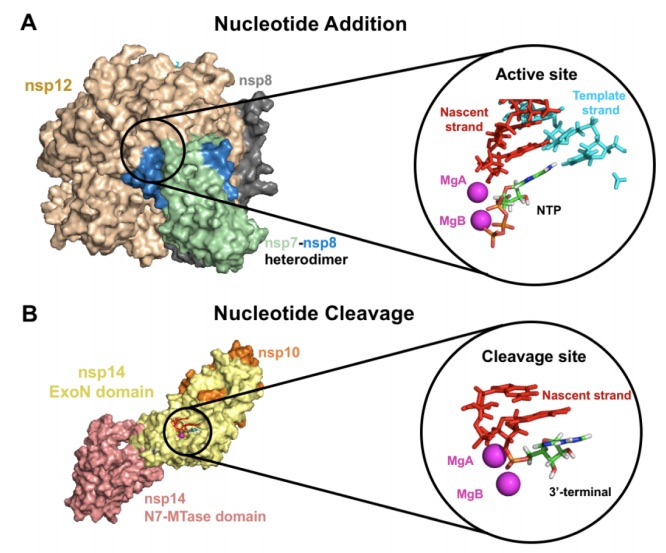Coronavirus (CoV) has a capsid that envelops the single-stranded RNA genome. Three structural proteins are shown to be associated with the capsid: membrane, envelope, and the spike protein. Chemical compounds and monoclonal antibodies that target SARS-CoV-2 surface proteins have been under investigation for treating COVID-19. In addition, new vaccines targeting the viral surface antigens are under intense development for the prevention of COVID-19. Unfortunately, drugs and vaccines with inhibitory mechanisms targeting surface receptors may not be effective due to the constant evolution of surface receptors to acquire drug resistance and evade host immune response. In contrast, viral RNA-dependent-RNA polymerase (RdRp) is a protein that is deeply buried inside the viral capsule and is responsible for viral replication. Furthermore, the functional conservation of the RdRp renders it highly resistant to mutations. Hence, RdRp serves as a promising drug target.
Developing drugs targeting SARS-CoV-2 RdRp is a challenging task due to its intrinsic proof-reading exonuclease (ExoN) function. The replicase polyprotein of coronaviruses is a multifunctional protein that contains 16 non-structural proteins (nsp). Among them, nsp12 is the core catalytic subunit responsible for the nucleotide addition (see Fig. 1a). If nsp12 made an error to incorporate a mismatched nucleotide, nsp14-ExoN will correct the mistake by cleaving this mis-incorporated nucleotide (see Fig. 1b). NTP analogs can inhibit the catalytic core subunit of nsp12, but to counteract NTP analogs incorporation into the nascent RNA, nsp14’s intrinsic proofreading function removes the incorporated NTP analogue. Remdesivir is a promising drug candidate to treat COVID-19 infection largely due to its ability to inhibit both nucleotide addition (nsp12) and cleavage (nsp14).

The Huang lab from the Hong Kong University of Science and Technology has released a series of Folding@Home projects to simulate the nsp12 and nsp14 complex. We will screen existing FDA-approved NTP analog drugs. We aim to repurpose drugs that can inhibit SARS-CoV-2 replication.
